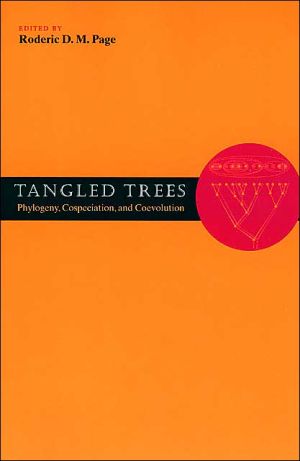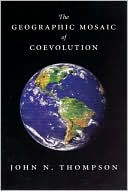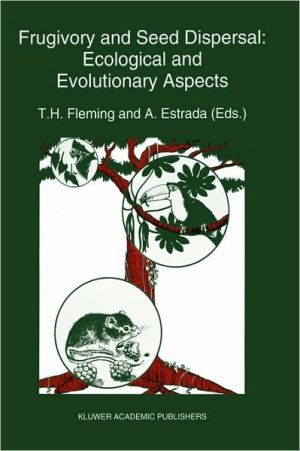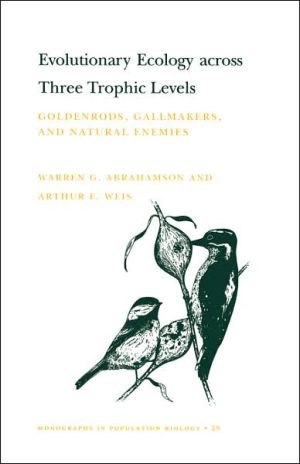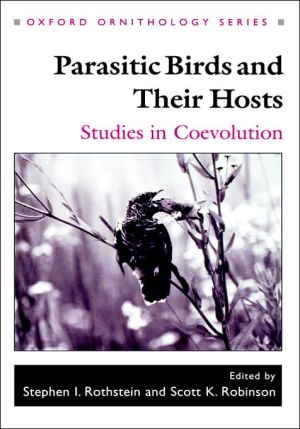Tangled Trees: Phylogeny, Cospeciation, and Coevolution
In recent years, the use of molecular data to build phylogenetic trees and sophisticated computer-aided techniques to analyze them have led to a revolution in the study of cospeciation. Tangled Trees provides an up-to-date review and synthesis of current knowledge about phylogeny, cospeciation, and coevolution. The opening chapters present various methodological and theoretical approaches, ranging from the well-known parsimony approach to "jungles" and Bayesian statistical models. Then a...
Search in google:
In recent years, the use of molecular data to build phylogenetic trees and sophisticated computer-aided techniques to analyze them have led to a revolution in the study of cospeciation. Tangled Trees provides an up-to-date review and synthesis of current knowledge about phylogeny, cospeciation, and coevolution. The opening chapters present various methodological and theoretical approaches, ranging from the well-known parsimony approach to "jungles" and Bayesian statistical models. Then a series of empirical chapters discusses detailed studies of cospeciation involving vertebrate hosts and their parasites, including nematodes, viruses, and lice. Tangled Trees will be welcomed by researchers in a wide variety of fields, from parasitology and ecology to systematics and evolutionary biology.Contributors:Sarah Al-Tamimi, Michael A. Charleston, Dale H. Clayton, James W. Demastes, Russell D. Gray, Mark S. Hafner, John P. Huelsenbeck, J.-P. Hugot, Kevin P. Johnson, Peter Kabat, Bret Larget, Joanne Martin, Yannis Michalakis, Roderic D. M. Page, Ricardo L. Palma, Adrian M. Paterson, Susan L. Perkins, Andy Purvis, Bruce Rannala, David L. Reed, Fredrik Ronquist, Theresa A. Spradling, Jason Taylor, Michael Tristem
TANGLED TREES \ Phylogeny, Cospeciation, and Coevolution \ \ THE UNIVERSITY OF CHICAGO PRESS \ Copyright © 2003 The University of Chicago\ All right reserved.\ ISBN: 978-0-226-64467-7 \ \ \ \ \ Chapter One \ INTRODUCTION \ Roderic D. M. Page\ These are exciting times in the study of cospeciation. The increasing ease with which phylogenetic data can be obtained, combined with ever more sophisticated tree building methods (Swofford et al., 1996), has resulted in a profusion of evolutionary trees (Pagel, 1999). At the same time, new developments in the theory of comparing host-parasite phylogenies have lead to further insights into the complexity of inferring the history of an association between a parasite and its host. In this chapter I review some basic concepts of cospeciation, and then guide the reader through the diverse contributions that make up the rest of this book.\ What Is Cospeciation?\ Cospeciation is the joint speciation of two or more lineages that are ecologically associated, the paradigm example being a host and its parasite. The association need not be parasitic; mutualistic, symbiotic, and other relationships may also show cospeciation. However, for convenience I will refer solely to hosts and parasites. If cospeciation were the only process occurring, the host and parasite phylogenies would be exact mirror images of each other. That this is rarely the case establishes that other process also occur (fig. 1.1). Rather than track their host with perfect fidelity, parasites may switch lineages (fig. 1.1b), speciate independently of their host (fig. 1.1c), go extinct (fig. 1.1d), fail to colonize all descendants of a speciating host lineage (fig. 1.1e), or fail to speciate when its host does (fig. 1.1f).\ It is important to distinguish between cospeciation and coevolution. If we define coevolution as the evolution of reciprocal adaptations in hosts and parasites, then it is clear that lineages can coevolve without cospeciating. Indeed, the studies that form the core of the coevolution literature do not involve cospeciating taxa (Thompson, 1994). However, it is difficult to imagine that cospeciation can occur without at least some degree of coevolution, although demonstrating such coevolution is another matter. Correlated character change in hosts and parasites may reflect other processes; for example, if both host and parasite genes are evolving in a clocklike manner, then overall amounts of molecular evolution in the two lineages will be correlated without their having coevolved. Better prospects for demonstrating coevolution in cospeciating lineages can be sought in characters directly involved in the host-parasite interaction (Clayton et al., 1999).\ Workers have differed on how to employ the terms cospeciation and coevolution (e.g., Clayton and Moore, 1997). Some prefer to restrict coevolution to mean just reciprocal adaptation between host and parasite, and treat cospeciation as a distinct process. For others (e.g., Brooks and McLennan, 1991, 1993) cospeciation is coevolution that occurs in macroevolutionary time; reciprocal adaptation is coevolution in microevolutionary time ("coadaptation"). Some balk at the process-oriented nature of the term cospeciation, especially as the pattern shown in figure 1.1a may occur between lineages at levels other than that of the species (e.g., Funk et al., 2000, and see chap. 5), and opt for terms such as cophylogeny or parallel cladogenesis. The chapters in this volume reflect this terminological pluralism, but in this chapter I shall use the term coevolution only in the sense of reciprocal selection.\ Why Is Cospeciation Interesting?\ A basic question to ask of any host and its parasite assemblage is, how old is their association-is the parasite an ancient associate or a recent acquisition? This question can be addressed by comparing host and parasite phylogenies to determine whether host and parasite have cospeciated. But beyond this fundamental concern with the tempo and mode of host-parasite evolution, cospeciation is of broader interest for a number of reasons, some of which I consider below.\ A Model System for Other Historical Associations\ Comparing host and parasite phylogenies is a special case of a more general problem that may be termed the study of "historical associations" (Page and Charleston, 1998). The parallels between biogeography, where we compare organismal phylogenies with cladograms depicting geological history (Rosen, 1978), and parasitology have long been appreciated (Hennig, 1966; Brooks, 1981a). However, the realization of the parallels between these problems and the relationship between gene trees and species trees has been a more recent development (e.g., Page, 1988, 1993; Doyle, 1992). This analogy (fig. 1.2) implies that a single method for reconstructing historical associations could be developed that would be applicable to all three kinds of association. The quest for such a method is the "holy grail" for theoreticians interested in historical associations. Dan Brooks's BPA method (see below) was developed to study host-parasite cospeciation (Brooks, 1981a), but has been applied to biogeography (Wiley, 1988) and molecular systematics (Doyle, 1992). In my own work I have explored the applicability of ideas derived from Goodman et al.'s (1979) method for reconciling gene trees and species trees to problems in biogeography and host-parasite associations.\ It is now widely appreciated that phylogenies for individual genes (or organelle genomes) need not be congruent with the organisms those genes were sampled from. Gene duplication, allelic polymorphism, and lineage sorting can result in incongruent gene and species trees. The use of phylogenies in studies of cospeciation rests on the notion that congruent phylogenies implies cospeciation, whereas incongruence implies host switching (Brooks and McLennan, 1991). The analogy with gene and species trees shows how misleading the latter assumption may be. Parasites are likely to be prone to similar processes; lineage sorting may occur due to parasite extinction or failure to colonize both descendants of a speciation event ("sorting events"); gene duplication is equivalent to in situ speciation of parasites on the same host (Page, 1994a). This analogy suggests that much of the theoretical and modeling work on the relationship between gene trees and species could be fruitfully applied to the study of host-parasite cospeciation. Indeed, chapter 5 in this book is a detailed exploration of the implications of population genetic models for the study of cospeciation.\ Comparative Biology\ If understanding the evolution of an adaptation requires knowledge of the historical context in which that character evolved, then cospeciation in hosts and parasites provides a unique opportunity to study adaptation. The ancestral environment of a parasite is its host, hence reconstructing the environment in which a feature of the parasite evolved corresponds to reconstructing its ancestral host. Although reconstructing ancestors is not necessarily straightforward (Cunningham et al., 1998), in many cases it is likely to be easier than attempting to reconstruct paleoenvironments of free living organisms. Standard comparative methods (Harvey and Pagel, 1991) can be used to compare changes in host and parasite traits. For example, Morand et al. (2000) showed that gopher louse body size is dependent on the size of their gopher hosts. This appears to be a consequence of a simple "lock-and-key" relationship between the thickness of gopher hair and the width of the groove in the louse's head with which it grips the host's hair shaft.\ Another reason that parasites are particularly attractive for comparative studies is that hosts frequently harbor several parasite lineages (fig. 1.3). The presence of replicate lineages opens up possibilities of comparative analyses of cospeciation and coevolution between lineages of parasites on the same hosts. Given two or more clades of parasites tracking the same hosts, we can ask whether they cospeciate to the same extent, and whether those cospeciation events occur at the same points on the host tree. Chapter 11 provides an example of just this approach. The presence of multiple parasites also offers the possibility of teasing apart the different contributions of host and parasite biology to the prevalence of cospeciation-for an example of this, see chapter 7.\ Rates of Evolution\ A long-standing question in parasitology concerns the relative rate of evolution in hosts and parasites. As Brooks and McLennan (1993) note, literature on this question has often failed to clearly distinguish between change within a lineage (anagenesis) and rates of origination and extinction of lineages (cladogenesis). Hence when authors state, for example, that parasites are evolving more slowly than their hosts, it is not always clear whether they mean that the parasites show less character change than their hosts, speciate less often, or both.\ Pairs of cospeciating hosts and parasites are of the same antiquity, and hence by comparing amounts of evolutionary divergence in the two lineages we can estimate their relative rate of evolution. While comparisons of amounts of morphological character change in hosts and parasites have led some to conclude that parasites are evolving less rapidly than their hosts (codified as "Manter's first rule": Brooks and McLennan, 1993, p. 15), such comparisons are fraught with difficulties. In contrast with molecular data, there is no single unit of morphological change that can be applied across disparate taxonomic groups. This absence of a common yardstick for morphological characters means that most recent work on rates of evolution in hosts and parasites has concentrated on molecular data. Examples include Moran et al.'s (1993) calibration of the rate of substitution in endosymbiotic bacteria with respect to their aphid hosts, and demonstrations of an elevated rate of substitution in louse mitochondrial DNA (Hafner et al., 1994; Page et al., 1998; Paterson et al., 2000). Cospeciating assemblages provide a unique opportunity to investigate the role factors such as generation time, population size, and metabolic rate may play in determining differences in the rate of molecular evolution among clades.\ Inferring Host Phylogeny from Parasites\ The use of parasites to infer host phylogeny is a long-standing tradition in parasitology (Klassen, 1992). If parasites are cospeciating with their hosts, then parasite phylogeny will, to a greater or lesser extent, reflect host phylogeny. One rationale for using parasites is the notion, mentioned above, that parasites evolve more slowly than their hosts. If this is the case, then parasites may retain characters indicative of relationships which have been lost in their hosts. However, at the molecular level, the evidence is that parasites are evolving more rapidly than their hosts (e.g., Hafner et al., 1994; Moran et al., 1995).\ Although early workers on taxonomy (e.g., Hopkins, 1942) enthused about the potential of lice as phylogenetic markers of their hosts, this tradition fell into disrepute. Only one author in this book attempts to infer host phylogeny using parasites (chap. 6). Paterson et al. (1995) recount the tense exchange between Ernst Mayr and the louse taxonomist Gunther Timmermann that occurred in 1957 during the Premier symposium sur la spécificité parasitaire des parasites de Vertébrés, held at the University of Neuch atel. Mayr accused Timmermann of placing a "child-like faith" in the evidence lice offered concerning avian relationships. At one point Mayr exclaimed:\ Two birds can exchange their parasites, nothing prevents this, but I have not yet seen two birds exchanging their heads, their wings or their legs. These have come down from its ancestors and not from another bird that nested in a hole right next to it! (Timmermann, 1957, p. 170)\ Mayr has a point (see chap. 13), but it is ironic that the flood of genomic data in which we are currently awash provides evidence for rampant lateral gene transfer among distantly related lineages (Martin, 1999). This reinforces the parallels between the different kinds of historical association (Page and Charleston, 1998). In one sense, molecular systematists making inferences of organismal phylogeny from gene phylogenies are in much the same boat as parasitologists. We cannot assume that all genes are faithfully tracking species trees as not all genes of a species have "come down from its ancestors." Given this parallel, perhaps it is time to rethink the possible utility of parasites as markers of host phylogeny.\ Methodological Issues\ In Klassen's (1992) interesting, if somewhat narrow, view of the history of cospeciation research, Dan Brooks is credited with creating a\ synthesis of the North American biogeographic paradigm with its European phylogenetic counterpart to provide a vibrant and everchanging methodological framework on which practically all coevolution research of the past decade has been based. (p. 584)\ Hyperbole aside, Brooks is largely responsible for reinvigorating the field of cospeciation in the late twentieth century. His pioneering work (Brooks, 1979, 1981, 1985, 1988) was the first serious attempt to marry quantitative phylogenetics and cospeciation. My own interest in the field as an undergraduate student was sparked by his paper on freshwater stingrays (Brooks et al., 1981), and by the appeal of a quantitative methodology (Brooks, 1981). Despite Klassen's assertion (p. 585) that "the historical questions of methodology [are] now solved," it soon became apparent that Brooks's method (christened "Brooks Parsimony Analysis," or BPA by Wiley, 1988) suffered from some serious problems (Page, 1990a; Ronquist and Nylin, 1990). Debate over the relative merits of BPA and alternative methods has at times been heated, and has been depicted as a clash between two different research traditions (e.g., Brooks, 1996; Hoberg et al., 1997). In reality, I think the dispute is more accurately (and modestly) represented as a reflection of the technical challenges posed by trying to incorporate horizontal transfer into any method for comparing host and parasite trees. As it turns out, neither BPA nor the solution I proposed (Page, 1994b) and implemented in TreeMap handled horizontal transfer entirely successfully-neither Brooks nor I were aware of how complicated the problem really is.\ The Problem of Horizontal Transfer\ If parasites either cospeciated (fig. 1.1a), speciated independently (fig. 1.1c), went extinct (fig. 1.1d), or missed the boat (fig. 1.1e), then the task of reconstructing the evolution of a host-parasite system would be straightforward, and was essentially solved by Goodman et al.'s reconciled tree concept. The simple biological fact that parasites can switch hosts poses not so simple methodological problems. Ronquist (1995) was one of the first to point out why the problem is difficult and why, for example, the solution that I had implemented in TreeMap could fail in some cases. Because postulating a horizontal transfer requires that the source and destination hosts are contemporaneous, we have to consider the relative ages of different host lineages. Failure to take this constraint into account can result in postulating transfers that are mutually incompatible (fig. 1.4). The complexity of the problem is reflected in the complexity of some of the proposed solutions, notably the "jungles" method developed by Charleston (1998). This topic is pursued further in chapters 2 and 3.\ (Continues...)\ \ \ \ \ Excerpted from TANGLED TREES Copyright © 2003 by The University of Chicago. Excerpted by permission.\ All rights reserved. No part of this excerpt may be reproduced or reprinted without permission in writing from the publisher.\ Excerpts are provided by Dial-A-Book Inc. solely for the personal use of visitors to this web site. \ \
ContributorsPreface1Introduction12Parsimony Analysis of Coevolving Species Associations223Lizards, Malaria, and Jungles in the Caribbean654A Statistical Perspective for Reconstructing the History of Host-Parasite Associations935Population Genetics and Cospeciation: From Process to Pattern1206New Evidence for Hystricognath Rodent Monophyly from the Phylogeny of their Pinworms1447Cospeciation and Horizontal Transmission Rates in the Murine Leukemia-Related Retroviruses1748Cophylogeny Between Pocket Gophers and Chewing Lice1959The Effects of Spatial and Temporal Scale on Analyses of Cophylogeny22110Have Mammals and their Chewing Lice Diversified in Parallel?24011Coevolutionary History of Ecological Replicates: Comparing Phylogenies of Wing and Body Lice to Columbiform Hosts26212Drowning on Arrival, Missing the Boat, and X-Events: How Likely are Sorting Events?28713The Ecological Basis of Coevolutionary History310Index343
